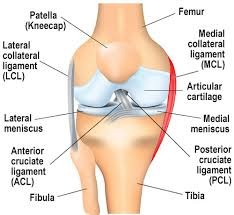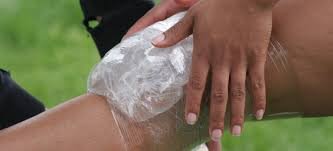
Last updated: June 2025
Medial collateral ligament (MCL) injuries are among the most common knee problems, affecting athletes and active individuals worldwide. If you’re dealing with MCL pain, you’re likely searching for effective treatment options that can get you back to your normal activities quickly and safely. This comprehensive guide covers everything you need to know about MCL pain treatment, from immediate relief strategies to advanced therapeutic approaches.

Understanding MCL Pain: What You Need to Know
The medial collateral ligament is a crucial stabilizing structure on the inner side of your knee. When injured, it can cause significant pain, swelling, and mobility limitations. MCL pain treatment success depends largely on understanding the severity of your injury and choosing the appropriate therapeutic approach.
MCL injuries are typically graded on a scale of 1-3:
- Grade 1: Mild stretching with minimal fiber damage
- Grade 2: Partial tearing with moderate instability
- Grade 3: Complete rupture requiring intensive treatment
Most MCL injuries occur during sports activities involving sudden direction changes, direct blows to the outer knee, or twisting motions. The good news is that MCL pain treatment has evolved significantly, offering multiple effective options for recovery.
Immediate MCL Pain Treatment: The First 48 Hours
The RICE Protocol for Acute MCL Pain
When MCL pain strikes, immediate action can significantly impact your recovery timeline. The proven RICE method remains the foundation of early MCL pain treatment:
Rest: Avoid activities that worsen your pain. This doesn’t mean complete immobilization, but rather avoiding movements that stress the injured ligament.
Ice: Apply ice packs for 15-20 minutes every 2-3 hours during the first 48 hours. This reduces inflammation and provides natural pain relief.
Compression: Use an elastic bandage or knee brace to provide support and reduce swelling. Ensure it’s snug but not so tight that it restricts circulation.
Elevation: When resting, elevate your leg above heart level to minimize swelling and promote healing.

When to Seek Professional Help
While many Grade 1 MCL injuries respond well to conservative MCL pain treatment, certain symptoms warrant immediate medical attention:
- Severe pain that doesn’t improve with rest and medication
- Significant knee instability or inability to bear weight
- Numbness or tingling in the leg or foot
- Signs of infection such as fever or increased warmth
Conservative MCL Pain Treatment Options
Non-Surgical Approaches That Work
Most MCL injuries heal successfully with conservative MCL pain treatment. These evidence-based approaches can provide significant relief while promoting natural healing:
Pain Management Medications
Over-the-counter anti-inflammatory medications like ibuprofen or naproxen can effectively reduce both pain and inflammation. For severe pain, your healthcare provider might prescribe stronger pain relievers or muscle relaxants as part of your MCL pain treatment plan.
Physical Therapy: The Cornerstone of Recovery
Physical therapy plays a crucial role in MCL pain treatment, helping restore strength, flexibility, and function. A qualified physical therapist will design a personalized program that typically includes:
- Range of motion exercises to prevent stiffness
- Strengthening exercises for supporting muscles
- Balance and proprioception training
- Functional movement patterns
- Manual therapy techniques
Bracing and Support
Knee braces can provide valuable support during MCL pain treatment. Different types serve various purposes:
- Hinged braces for moderate to severe injuries
- Compression sleeves for mild injuries and return to activity
- Functional braces for athletes returning to sports
Advanced Conservative Treatments
For persistent MCL pain that doesn’t respond to basic treatments, advanced options may be necessary:
Platelet-Rich Plasma (PRP) Therapy
PRP involves injecting concentrated platelets from your own blood into the injured area. This cutting-edge MCL pain treatment can accelerate healing by delivering growth factors directly to the damaged tissue.
Stem Cell Therapy
Emerging research suggests that stem cell injections may enhance MCL healing, though this treatment is still being studied and isn’t widely available.

Exercise-Based MCL Pain Treatment
Phase 1: Early Mobility (Days 1-7)
During the initial phase of MCL pain treatment, gentle movements help maintain circulation and prevent stiffness:
- Ankle pumps and circles
- Gentle quad sets (tightening thigh muscles)
- Heel slides with towel assistance
- Straight leg raises (when comfortable)
Phase 2: Strengthening (Weeks 2-6)
As pain decreases, focus shifts to rebuilding strength:
- Wall sits and mini squats
- Hamstring and calf strengthening
- Hip abductor exercises
- Stationary bike (when comfortable)
Phase 3: Functional Training (Weeks 6+)
Advanced exercises prepare you for return to normal activities:
MCL Recovery Timeline
3 Phases of Exercise Progression for Optimal Healing
Early Mobility Phase
Primary Goals
- Reduce pain and inflammation
- Maintain basic circulation
- Prevent muscle atrophy
- Begin gentle movement
Strengthening Phase
Primary Goals
- Rebuild muscle strength
- Improve range of motion
- Enhance stability
- Progress weight-bearing
Functional Training Phase
Primary Goals
- Sport-specific movements
- Advanced balance training
- Return to full activity
- Injury prevention
Important: Always consult with a healthcare professional or physical therapist before beginning any exercise program. Progress through phases should be based on individual healing and professional guidance, not just time elapsed.
- Plyometric exercises
- Sport-specific movements
- Balance challenges
- Agility drills
Surgical MCL Pain Treatment
When Surgery Becomes Necessary
While most MCL injuries heal with conservative treatment, surgery may be required for:
- Complete Grade 3 tears with significant instability
- Multiple ligament injuries
- Chronic instability after failed conservative treatment
- Avulsion fractures
Surgical Options
MCL reconstruction or repair procedures have high success rates when conservative MCL pain treatment fails. Modern techniques often use minimally invasive approaches to reduce recovery time and complications.
[IMAGE 4 PLACEHOLDER: Arthroscopic surgery setup for knee procedures – Alt text: “Modern arthroscopic equipment for MCL surgical treatment”]
Alternative MCL Pain Treatment Methods
Complementary Therapies
Many patients find relief through alternative approaches:
Acupuncture
Studies suggest acupuncture can reduce pain and inflammation while promoting healing. Many patients incorporate this into their comprehensive MCL pain treatment plan.
Massage Therapy
Therapeutic massage can improve circulation, reduce muscle tension, and promote relaxation during recovery.
Cold Laser Therapy
Low-level laser therapy may accelerate tissue healing and reduce pain, though research is ongoing.
Nutritional Support for Healing
Proper nutrition supports MCL pain treatment by providing essential building blocks for tissue repair:
- Protein for tissue rebuilding
- Vitamin C for collagen synthesis
- Omega-3 fatty acids for inflammation control
- Calcium and vitamin D for bone health
Prevention: The Best MCL Pain Treatment
Strengthening for Prevention
The most effective MCL pain treatment is prevention. Key strategies include:
- Regular quadriceps and hamstring strengthening
- Hip stabilizer exercises
- Proper warm-up and cool-down routines
- Flexibility maintenance
- Sport-specific conditioning
Equipment and Technique
Using proper equipment and technique can significantly reduce MCL injury risk:
- Appropriate footwear for your activity
- Proper landing and cutting techniques
- Gradual training progression
- Environmental awareness
[IMAGE 5 PLACEHOLDER: Athletes demonstrating proper landing technique – Alt text: “Proper athletic technique to prevent MCL injuries”]
Recovery Timeline and Expectations
Understanding realistic timelines helps set appropriate expectations for MCL pain treatment:
- Grade 1 injuries: 2-4 weeks
- Grade 2 injuries: 4-8 weeks
- Grade 3 injuries: 8-12 weeks (conservative) or 4-6 months (surgical)
Recovery varies based on individual factors including age, fitness level, adherence to treatment, and injury severity.
Red Flags: When to Modify Your MCL Pain Treatment
Monitor these warning signs that may indicate complications:
- Increasing pain despite treatment
- New onset of instability
- Persistent swelling after several weeks
- Changes in sensation or circulation
Working with Healthcare Professionals
Building Your Treatment Team
Effective MCL pain treatment often involves multiple professionals:
- Primary care physician for initial assessment
- Orthopedic specialist for complex cases
- Physical therapist for rehabilitation
- Sports medicine physician for athletic concerns
Questions to Ask Your Provider
- What grade is my MCL injury?
- What MCL pain treatment options are best for my situation?
- When can I return to normal activities?
- What warning signs should I watch for?
- How can I prevent future injuries?
The Future of MCL Pain Treatment
Emerging Technologies
Research continues to advance MCL pain treatment options:
- Bioengineered scaffolds for tissue repair
- Gene therapy approaches
- Advanced imaging for precise diagnosis
- Robotic-assisted rehabilitation
Personalized Medicine
Future MCL pain treatment may be tailored to individual genetic profiles, optimizing healing based on your unique biological makeup.
Conclusion: Your Path to MCL Pain Relief
MCL pain treatment has never been more effective or comprehensive. Whether you’re dealing with a minor strain or a complete rupture, multiple proven treatment options can help you recover fully and return to your active lifestyle.
The key to successful MCL pain treatment lies in early intervention, appropriate treatment selection, and consistent adherence to your rehabilitation program. Most patients who follow evidence-based treatment protocols experience excellent outcomes and return to their pre-injury activity levels.
Remember that every MCL injury is unique, and what works best for one person may not be optimal for another. Work closely with qualified healthcare professionals to develop a personalized MCL pain treatment plan that addresses your specific needs, goals, and circumstances.
Don’t let MCL pain sideline you indefinitely. With the right treatment approach and commitment to recovery, you can overcome this injury and come back stronger than before. Start your journey to pain-free movement today by consulting with a healthcare provider who specializes in MCL pain treatment.
Disclaimer: This information is for educational purposes only and should not replace professional medical advice. Always consult with a qualified healthcare provider before beginning any MCL pain treatment program.
Call-to-Action: Ready to start your MCL pain treatment journey? Contact our specialists today for a personalized assessment and treatment plan. Your pain-free future begins with the right treatment approach.
